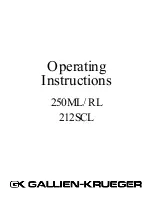
9
18. APPLICATION
Using the Q-Pre
It could not be simpler to use and operate the Q-Pre. Each of the four pre-amplifier
channels has its own input and output and variable gain control.
Three steps:
18.1 Simply connect a signal for processing to one of the XLR balanced inputs on the
front of the Q-Pre.
18.2 Make a connection from the corresponding channel output on the front of the
Q-Pre to your desired destination (Mixer, recorder, etc).
18.3 Adjust the variable gain control to the desired pre-amplified level. To ensure
sure you do not over pre-amplify your signal a peak clip indicator light has been
provided on the front panel of the Q-Pre for each channel. When illuminated, this
light indicates that the preamplifier is overloaded and that distortion will occur.
Please turn down the variable gain control for the currently selected channel until
the peak clip light is no longer illuminated. Always trust your ears, the Peak LED is
after the gain control so you could actually distort the input with a very high level.
19. SPECIFICATIONS
AUDIO INPUTS & PRE AMPS:
Connectors XLR
Type
balanced
Impedance
2k
Ohms
Min Sensitivity -40dB
Peak input level +5dB
Gain control range 50dB
Peak amplification 74dB
Phantom power +48V, switchable
AUDIO OUTPUTS:
Connectors 1/4“ jack
Type TRS balanced
Impedance -10dB 47K
Peak output level +18.5dB
DIST, FREQ, S/N RATIO & CROSSTALK:
Frequency response 20Hz~20kHz, 0dB~-2B
Distortion 0.02%
S/N Ratio better than 80dB
Crosstalk rejection >70dB@1kHz;-20dBinput
POWER SUPPLY:
~ 100-120 V AC, ~ 200-240 V AC, 50-60 Hz
Power consumption 8.5VA
Fuse 100-120 V AC: 630 mA (slow-blow)
200-240 V AC: 315 mA (slow-blow)
PHYSICAL:
Dimension 1 3/4“ (44.5 mm) * 19“ (482.6 mm) * 8 1/2“ (217 mm)
Net weight approx. 3.4 kg






























